外研版(2019)选择性必修第二册Unit 4 Breaking Boundaries Starting out课件(共13张PPT)
文档属性
| 名称 | 外研版(2019)选择性必修第二册Unit 4 Breaking Boundaries Starting out课件(共13张PPT) |
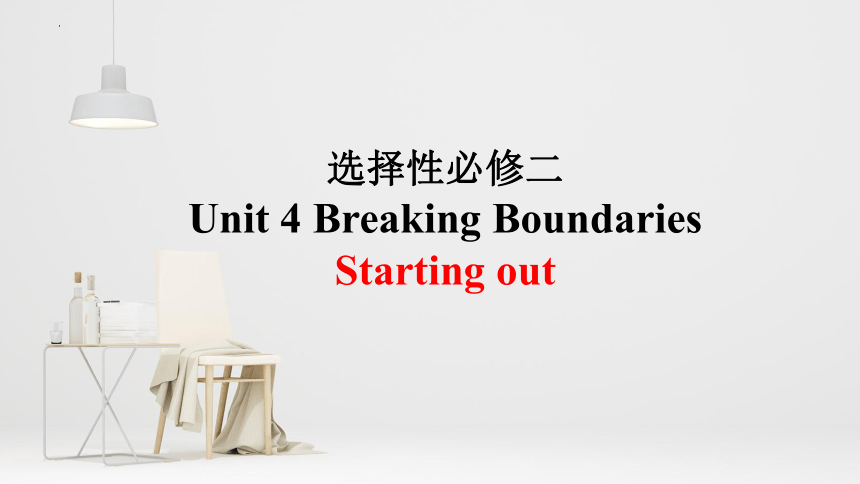
|
|
| 格式 | pptx | ||
| 文件大小 | 4.0MB | ||
| 资源类型 | 教案 | ||
| 版本资源 | 外研版(2019) | ||
| 科目 | 英语 | ||
| 更新时间 | 2024-05-17 15:16:05 | ||
图片预览

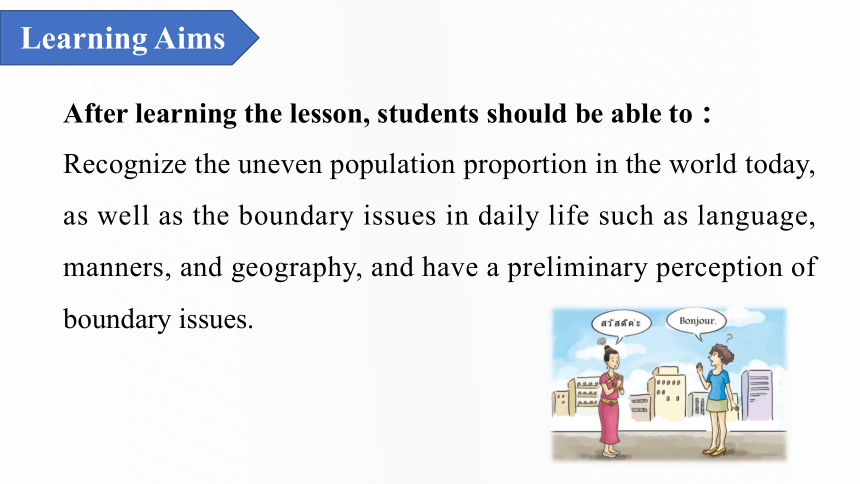
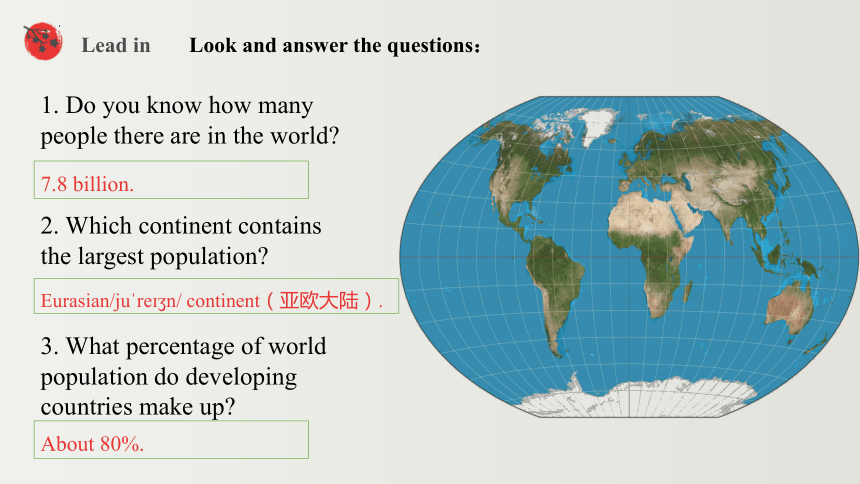
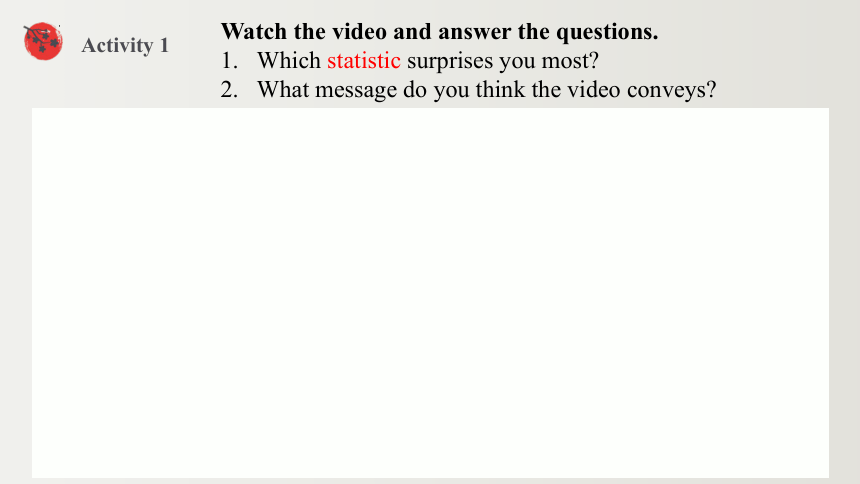
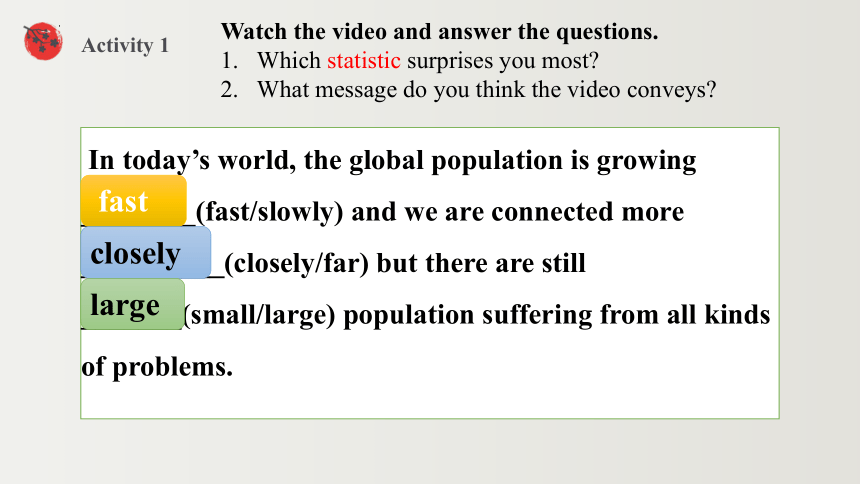
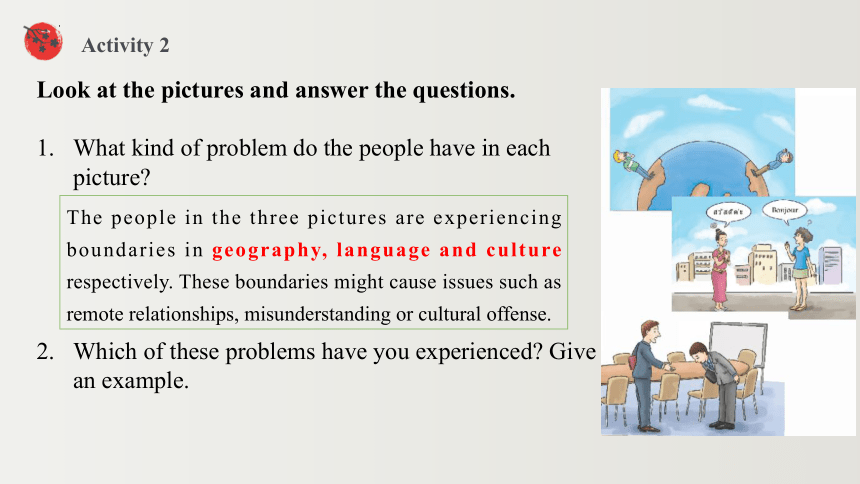
文档简介
(共13张PPT)
选择性必修二
Unit 4 Breaking Boundaries
Starting out
After learning the lesson, students should be able to:
Recognize the uneven population proportion in the world today, as well as the boundary issues in daily life such as language, manners, and geography, and have a preliminary perception of boundary issues.
Learning Aims
Lead in
1. Do you know how many people there are in the world
2. Which continent contains the largest population
3. What percentage of world population do developing countries make up
7.8 billion.
Eurasian/ju re n/ continent(亚欧大陆).
About 80%.
Look and answer the questions:
Activity 1
Watch the video and answer the questions.
Which statistic surprises you most
What message do you think the video conveys
Activity 1
In today’s world, the global population is growing ________(fast/slowly) and we are connected more __________(closely/far) but there are still _______(small/large) population suffering from all kinds of problems.
fast
closely
large
Watch the video and answer the questions.
Which statistic surprises you most
What message do you think the video conveys
Activity 2
Look at the pictures and answer the questions.
What kind of problem do the people have in each picture
Which of these problems have you experienced Give an example.
The people in the three pictures are experiencing boundaries in geography, language and culture respectively. These boundaries might cause issues such as remote relationships, misunderstanding or cultural offense.
Activity 2
boundaries in language
boundaries in manners
boundaries in geography
3.What do the three pictures have in common
They are all about boundaries in our daily life.
Activity 3
Discuss and summarize:What is boundary
1. The river is the boundary between the two countries.2. People need to have a sense of boundaries when interacting with people .
3. There are certain rules and boundaries from big countries to the small ones.
4. Breaking boundaries means innovation.
5. Boundaries are everywhere. Some are for security. Some are for privacy. But some are just for us to break.
Activity 3: Extra
boundary, border, bounds, frontier, limit
名词,"边界,边境"
boundary: 侧重地图上正式标定的、双方遵守的边界,也可指较小行政单位间的界线。
border: 多指国与国之间或两地区的分界处,即分界线附近的边缘部分。
bounds: 常与boundary换用,指土地边界,但意思不如boundary明确,主要用于抽象事物和文学作品中。
frontier: 指两国接壤的前沿地区,属于各国的国境和边疆,多指设防的边界。
limit: 含义广泛,常用作复数。指任何界限、范围、分界线外面的部分,可指有形或无形的东西。
Activity 4
Share an unforgettable boundary experience.
Groupwork & Presentation
Self-evaluation
1.Do you know the words about boundary
2. Can you make a summary about boundary
3. Can you describe an unforgettable experience
about boundary
Homework
1.Polish your summary.
2.Organize your unforgettable boundary experience into an article.
Thanks for listening!
选择性必修二
Unit 4 Breaking Boundaries
Starting out
After learning the lesson, students should be able to:
Recognize the uneven population proportion in the world today, as well as the boundary issues in daily life such as language, manners, and geography, and have a preliminary perception of boundary issues.
Learning Aims
Lead in
1. Do you know how many people there are in the world
2. Which continent contains the largest population
3. What percentage of world population do developing countries make up
7.8 billion.
Eurasian/ju re n/ continent(亚欧大陆).
About 80%.
Look and answer the questions:
Activity 1
Watch the video and answer the questions.
Which statistic surprises you most
What message do you think the video conveys
Activity 1
In today’s world, the global population is growing ________(fast/slowly) and we are connected more __________(closely/far) but there are still _______(small/large) population suffering from all kinds of problems.
fast
closely
large
Watch the video and answer the questions.
Which statistic surprises you most
What message do you think the video conveys
Activity 2
Look at the pictures and answer the questions.
What kind of problem do the people have in each picture
Which of these problems have you experienced Give an example.
The people in the three pictures are experiencing boundaries in geography, language and culture respectively. These boundaries might cause issues such as remote relationships, misunderstanding or cultural offense.
Activity 2
boundaries in language
boundaries in manners
boundaries in geography
3.What do the three pictures have in common
They are all about boundaries in our daily life.
Activity 3
Discuss and summarize:What is boundary
1. The river is the boundary between the two countries.2. People need to have a sense of boundaries when interacting with people .
3. There are certain rules and boundaries from big countries to the small ones.
4. Breaking boundaries means innovation.
5. Boundaries are everywhere. Some are for security. Some are for privacy. But some are just for us to break.
Activity 3: Extra
boundary, border, bounds, frontier, limit
名词,"边界,边境"
boundary: 侧重地图上正式标定的、双方遵守的边界,也可指较小行政单位间的界线。
border: 多指国与国之间或两地区的分界处,即分界线附近的边缘部分。
bounds: 常与boundary换用,指土地边界,但意思不如boundary明确,主要用于抽象事物和文学作品中。
frontier: 指两国接壤的前沿地区,属于各国的国境和边疆,多指设防的边界。
limit: 含义广泛,常用作复数。指任何界限、范围、分界线外面的部分,可指有形或无形的东西。
Activity 4
Share an unforgettable boundary experience.
Groupwork & Presentation
Self-evaluation
1.Do you know the words about boundary
2. Can you make a summary about boundary
3. Can you describe an unforgettable experience
about boundary
Homework
1.Polish your summary.
2.Organize your unforgettable boundary experience into an article.
Thanks for listening!
